AP Physics 1 🎡
257 resourcesSee Units
Answers and Review for Multiple Choice Practice on Dynamics

Image courtesy of Pixabay
⛔STOP ⛔ Before you look at the answers make sure you gave this practice quiz a try so you can assess your understanding of the concepts covered in Unit 2. Click here for the practice questions: AP Physics 1 Unit 2 Multiple Choice Questions.
Facts about the test: The AP Physics 1 exam has 50 multiple choice questions (45 single-select and 5 multiple-select) and you will be given 90 minutes to complete the section. That means it should take you around 15 minutes to complete 8 questions.
The following questions were not written by College Board and, although they cover information outlined in the AP Physics 1 Course and Exam Description, the formatting on the exam may be different.
1. A 50.0 N box is at rest on a horizontal surface. The coefficient of static friction between the box and the surface is 0.50, and the coefficient of kinetic friction is 0.40. A horizontal 20.0 N force is then exerted on the box. The magnitude of the acceleration of the box is most nearly
A. 0 m/s/s
B. 1 m/s/s
C. 2 m/s/s
D.4 m/s/s
Answer: The frictional force on the box can be found using f = mu * Fn, which is 25N (use the static coefficient because the box isn't moving). This is greater than the applied force of 20N, so the box will remain stationary
📄 Study AP Physics 1, Unit 2.3: Contact Forces
2. The boxes are released from rest, assuming friction is negligible what is the acceleration of the 2kg block?
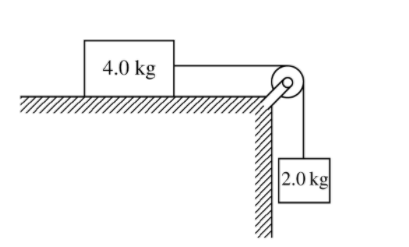
A. 0 m/s/s
B. 3.3 m/s/s
C. 5 m/s/s
D. 10 m/s/s
Answer: Use Newton's 2nd Law and treat both boxes as a single system. The weight of the 2kg block is the only outside force acting on the system. So F = ma => 20N = 6a => a = 20/6 = 3.3 m/s/s
📄 Study AP Physics 1, Unit 2.6: Newton's Second Law
3. If the boxes are held in equilibrium, what is the minimum coefficient of static friction between the 4.0kg block and the tabletop?
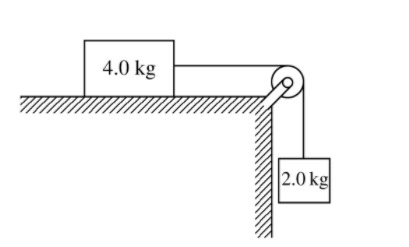
A. 0.25
B. 0.5
C. 0.75
D. 1
Answer: If the blocks are in equilibrium, then the weight of the 2.0kg block must be equal to the frictional force between the 4.0kg block and the table. 20N = mu(Fn) => 20N = mu(40N) => mu = 0.5
📄 Study AP Physics 1, Unit 2.4: Newton's First Law
4. Each of these graphs show the motion of an object traveling in a straight line.

Which of these graphs shows an object in equilibrium?
A. I
B. II
C. III
D. I and II
Answer: In equilibrium, the object's acceleration is zero. Therefore the velocity must be constant. Since the slope of a distance vs time graph is velocity, I and II are correct
📄 Study AP Physics 1, Unit 2.4: Newton's First Law
5. Each of these graphs show the motion of an object traveling in a straight line.
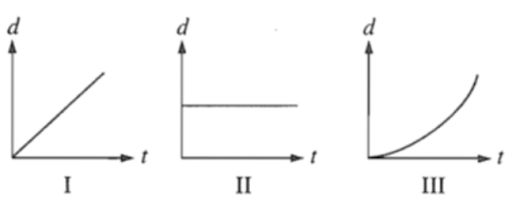
Which of these graphs shows an object with a non-zero net force?
A. I
B. II
C. III
D. I and II
Answer: A non-zero net force means that the object must be accelerating, so the slope of a distance vs time graph must be changing. Only graph III shows that.
📄 Study AP Physics 1, Unit 2.6: Newton's Second Law
6. The weight of an 10kg box is approximately
A. 1N
B. 10N
C. 100N
D. 1000N
Answer: Fg = mg so Fg = 10kg(10m/s/s) = 100N
7. What is the acceleration of this object?

A. 0 m/s/s
B. 1 m/s/s
C. 2 m/s/s
D. 3 m/s/s
Answer: Newton's 2nd Law: The net force on the object is 10N (20-10) and the mass is 10kg, so F = ma => a = 10/10 = 1m/s/s
📄 Study AP Physics 1, Unit 2.2: The Gravitational Field
8. What is the magnitude of the normal force acting on the box?
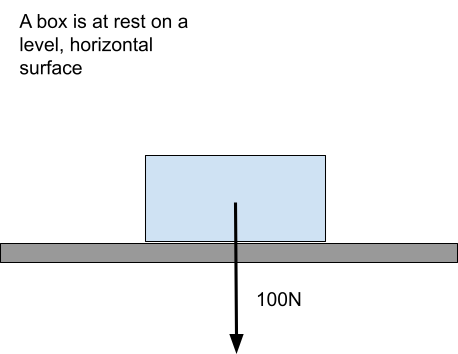
A. 0N
B. 10kg
C. 100N
D. Can't be determined
Answer: The normal force is caused by the table pushing up on the box. It is an action-reaction forces, which according to Newton's 3rd Law must be equal to the weight of the box (100N)
📄 Study AP Physics 1, Unit 2.5: Newton's Third Law and Free-Body Diagrams
9.
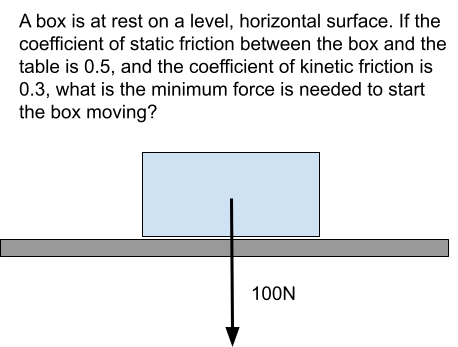
A. 30N
B. 50N
C. 100N
D. 150N
Answer: Calculate the force of static friction using f = mu * Fn where Fn = mg = 100N. Use static friction because the box is at rest.
📄 Study AP Physics 1, Unit 2.3: Contact Forces
10.
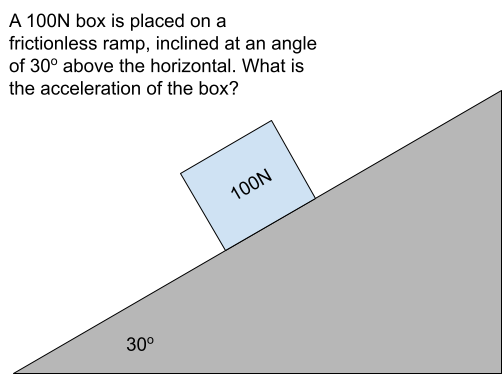
A. 0.5 m/s/s
B. 1 m/s/s
C. 5 m/s/s
D. 10 m/s/s
Answer: The net force on the box is the parallel component of the weight (mgsin(Q) = 100sin(30) = 50N). Use Newton's 2nd Law to calculate the acceleration (F = ma => 50N = 10kg (a) => a = 5m/s/s)
📄 Study AP Physics 1, Unit 2.6: Newton's Second Law
11.

A. 0N
B. 50N
C. 87N
D. 100N
Answer: The normal force must be equal to the perpendicular component of the weight. (Fn = mgcos(Q) = 100 cos(30) = 87N)
📄 Study AP Physics 1, Unit 2.5: Newton's Third Law and Free-Body Diagrams
12. A person stands on a scale in an elevator. If the scale reads 600 N when that person is riding upward at a constant velocity of 10 m/s, what is the scale reading when the elevator is at rest?
A. 200N
B. 400N
C. 600N
D. 800N
Answer: Constant velocity means that the forces on the person are balanced (Fscale = Fg). This also is true when the person is stationary (constant 0 velocity). The only times when the scale will not be the same as the weight is when the elevator is accelerating.
📄 Study AP Physics 1, Unit 2.7: Applications of Newton's Second Law
13. A student records the following velocity vs time data watching a 0.2kg block slide across a rough horizontal surface.
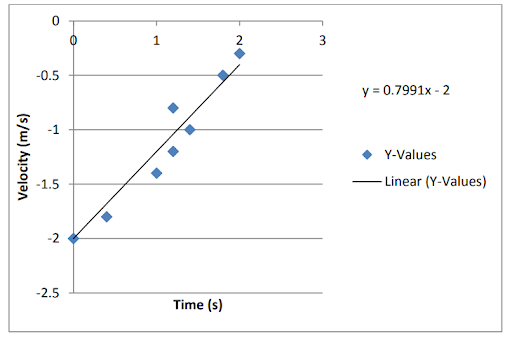
What is the magnitude of the frictional force acting on the block?
A. 0.08N
B. 0.16N
C. 0.799N
D. 2N
Answer: The slope of the graph is the acceleration. Since the only unbalanced force acting on the block is friction, use F = ma to get 0.16N
📄 Study AP Physics 1, Unit 2.5: Newton's Third Law and Free-Body Diagrams
14. A simple Atwood machine is created by hanging two blocks over a fixed, massless pulley. If the blocks are released, what is the acceleration of the 5kg block?
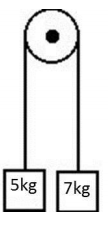
A. 1.67 m/s/s
B. 2.86 m/s/s
C. 4 m/s/s
D. 14 m/s/s
Answer: Use Newton's 2nd Law and treat both boxes as a single system. F = ma => 70N - 50N = (7kg + 5kg) a => a = 20N / 12kg = 1.67m/s/s
📄 Study AP Physics 1, Unit 2.6: Newton's Second Law
15. A cart (m1 = 2kg) is setup so it slides across the tabletop. It’s attached to a hanging mass (m2 = 10kg) and released from rest. The coefficient of kinetic friction between the cart and the tabletop is 0.5. What is the acceleration of the cart?
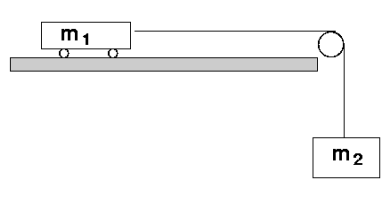
A. 7.5 m/s/s
B. 8.25 m/s/s
C. 9.17 m/s/s
D. 10 m/s/s
Answer: Use Newton's 2nd Law and treat the cart and the hanging mass as a single system. F = ma => M2g - Ff = (M1+M2)a => 100N - 0.5(20N) = 12kg (a) => a = 90N / 12kg = 7.5m/s/s
- 🔍Check out all of the AP Physics 1 Unit 3 Resources
- 🦘Jump to AP Physics 1 Unit 3 Multiple Choice Questions
- 🤝Connect with other students studying AP Physics 1 with Hours
Browse Study Guides By Unit
👟Unit 1 – Kinematics
🌀Unit 2 – Dynamics
🚀Unit 3 – Circular Motion & Gravitation
⚡️Unit 4 – Energy
⛳️Unit 5 – Momentum
🎸Unit 6 – Simple Harmonic Motion
🎡Unit 7 – Torque & Rotational Motion
💡Unit 8 – Electric Charges & Electric Force
🔋Unit 9 – DC Circuits
🔊Unit 10 – Mechanical Waves & Sound
👉AP Physics Essentials
🧐Multiple Choice Questions (MCQs)
✍️Free Response Questions (FRQs)
📆Big Reviews: Finals & Exam Prep

Fiveable
Resources
© 2023 Fiveable Inc. All rights reserved.